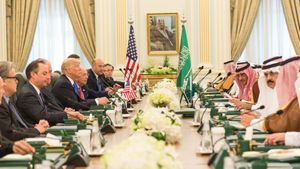Intel Corporation has entered a new phase of chip production with the deployment of high numerical aperture (NA) extreme ultraviolet (EUV) lithography machines from ASML Holding, marking significant strides toward recovering its former dominance in semiconductor manufacturing.
During a recent conference held in San Jose, California, Intel's senior principal engineer, Steve Carson, revealed the company had successfully processed 30,000 silicon wafers within just one quarter using ASML's cutting-edge machinery. 'We’re getting wafers out at a consistent rate, and that's a huge boon to the platform,' Carson stated, underscoring the improved efficiency brought by this new technology.
This high-NA lithography technology signifies a strategic pivot for Intel, which previously struggled to keep pace with competitors such as Taiwan Semiconductor Manufacturing Company (TSMC). Intel's adoption of this advanced technology marks the first time any chipmaker has leveraged ASML’s latest generation of machines, representing not just recovery but potential revival for the company, which lost its leadership position largely due to delays and reliability issues with earlier EUV systems.
According to industry experts, Intel's previous EUV machines took seven long years to achieve full production reliability, contributing to the company’s struggle to hang onto its once-unquestioned market-leading status. With the transition to ASML's new high-NA machines, Intel is anticipated to produce chips using significantly fewer exposures than the previous generation—cutting down processing steps from 40 to as few as single digits. This transition not only streamlines production but also leads to lower costs and quicker turnaround times for manufacturing innovations.
The production of 30,000 wafers highlights the new machinery’s reliability and output efficiency. Carson added, 'The ASML machines can complete tasks with just one exposure, marking a revolutionary change from the previous requirement of three exposures,' reiteratively emphasizing the operational advantages of this transition.
Intel plans on utilizing these advancements to bring its 18A manufacturing process to mass production later this year, focusing especially on developing next-generation PC chips. The company expressed its intention to leverage high-NA lithography for its future 14A manufacturing technology, though it has not publicly confirmed the timeline for mass production of this latest technology.
ASML's high NA lithography machines function by using beams of light to print extremely precise features onto semiconductor wafers, which are foundational for the production of modern chips. This precision is expected to enable smaller and faster computing chips, directly addressing the rising demands for computing power driven by modern applications and devices.
Intel's recent announcements come at a time when the company is reevaluulating its overall capital expenditures and sharpening its focus on next-gen node development, even as broader economic pressures loom. Reports suggest the semiconductor giant aims to reduce its capital expenditure from $24 billion planned for 2024 to $20 billion for 2025, as it efficiently allocates resources toward accelerating advanced chip production technologies, as supported by ASML's latest equipment.
Nevertheless, challenges remain, including industry skepticism about the viability of scaling up the manufacturing process. Concerns were raised about yield rates, with past estimates indicating yields often hover around 20%-30%, which can hinder mass production capabilities. This situation presents hurdles Intel must navigate carefully as it seeks to reclaim its title and competitive standing within the semiconductor industry.
The U.S. government equally plays a notable role in these developments, as new semiconductor restrictions on China highlight geopolitical challenges facing American technologists. Such dynamics could potentially affect Intel's operations and its ability to compete effectively on both national and global stages, as the stakes of technological leadership rise.
Intel's investment and efforts toward overcoming its previous setbacks come with pressures to innovate quickly and maintain quality, ensuring they are back on winning footing amid fierce competition. The early success and production rates with the high-NA lithography machines are promising but represent merely the first steps down what could be a lengthy road to recovery and renewed leadership.
To put things simply, this pivotal deployment may very well dictate the competitive future of semiconductor production efficiency and positioning, and Intel is clearly banking on these new technologies to restore its once-stalwart industry position against relentless competition.



